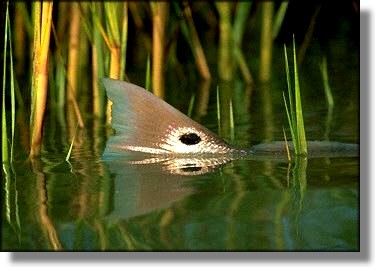You'll discover this isn't rocket science. Reading a flat is a method of scouting
for game fish, some species are easier to read than others. What we want to
learn to do is understand the habitat, learn what is constant and what is different.
We also have to understand the fish we are stalking and their predatory actions.
In Florida, everyday is like being in paradise. Take a moment when you are out
on the water and just look around, listen to the sounds of the birds, feel the breeze
and watch how it moves the grasses around. Look into the water and see what
swims, walks or crawls on the bottom. Notice the bottom material. Are there
oysters on the bottom, is it muddy, are there grass, reeds, or plants there? All
of these observations are clues to what habitat fish encounter to stay alive.
When you run at high speed across a lagoon you won't see anything up close.
Look out 20 to 30 feet at an angle and a whole new world will open up to you.
There are as many ways to read a flat as there are opinion's on the subject. In
North Florida our flats are different from the Keys, but the basics of reading water
are the same. Let's take this boat and run along a slough in the flats.
First you'll notice a slough is darker water. Darker water is usually deeper water
and that's where you want to run. (Unless the bottom is dark from vegetation, then
you want to ask a guide or someone who knows the water.) Usually its depth varies
from about 18 inches to more than 3 feet. Lighter water on the edges is really shallow
and you can see bottom. At high speed, 25 to 30 miles per hour, it is difficult to focus
on the bottom near the boat, it just whizzes by. The bottom is moving fast, but you can
see changes in the color of the bottom structure (sand or mud), vegetation colorations
(greens to yellow to tan) and some of the plants that grow there. Just don't run where
you see birds walking. This is an indication of shallow water. The presence of birds is a
good sign that bait fish are abundant!
Also pay attention to the wind and currents. Sometimes the wind will blow water across
a drop off. The wave action will move bait fish in the same direction and into the waiting
mouths of hungry fish. Check out what is happening with the current. When a small
channel empties into a flat it usually brings bait fish onto the flat and the delta around this
area will hold predators waiting for an easy meal.
Remember predatory fish need cover so they can ambush their prey. In North
Florida prey nets out to pilchards, silversides, finger mullet, pig fish or pin fish, crabs,
shrimp and sea worms. Except for pig and pin fish, the others swim in small, tightly
grouped pods and sometimes larger schools. They move as a pack because there is
bigness and safety in numbers. The predator fish will be hiding in the grass or near a
drop off on an oyster bed, or where there is fast moving water, and usually when there
is bait fish available for an easy meal.
Most fish will swim in pairs or groups of six to eight fish. Sometimes you'll find them
in pods of 20 to 30 fish and occasionally will come upon a school of 100 to 200 fish.
These are usually Red fish or Blackdrum (e.g., Red Drum, Red Channel Bass).
Trout don't usually travel in pods, but small groups are common. Trout tend to be
more solitary than red fish. However, the exception is for trout caught in a pod of reds.
Sometimes jacks will take cover beneath a school of reds.

When scouting the flat, a guide usually will look for signs of tailing reds or rollovers.
Tailing reds are common when reds are feeding on crabs. Their noses are down and
the tails are up. In shallow water the tails will protrude above the water. Rollovers
might be trout or baby tarpon. This usually happens when predator fish push bait
fish up on a flat and get stuck on a falling tide. The fish literally rollover. Rollovers
are also evident when fishing a back-country creek. The fish will rollover and expose
its underside.
Trout usually hang off a white spot, an area that is bare of weeds or grass. They will
hang back just off the white spot and wait for bait fish to come in range. You can see
trout and pick them up. You'll notice that a stationary trout is nose into a current or
tide. He will lie motionless and look like a fat, dark log. Trout will position themselves
just into the white spot, a quarter in the white spot and the rest of their body in the grass.
In shallow water he stands out because his shape is different from the grass around him.
The types of actions by these fish will also give away the bottom conditions. Tailing reds
usually near or on an oyster bed indicates a harder bottom including hard packed sand.
Trout and reds that move through the grasses are in areas of soft, muck bottoms.
By studying the flat you will sharpen your senses and learn what is fish and what is cover.
Once you start recognizing the signs of activity you'll catch a lot more fish.
~ Doug
Next time: What's for Dinner!
|



